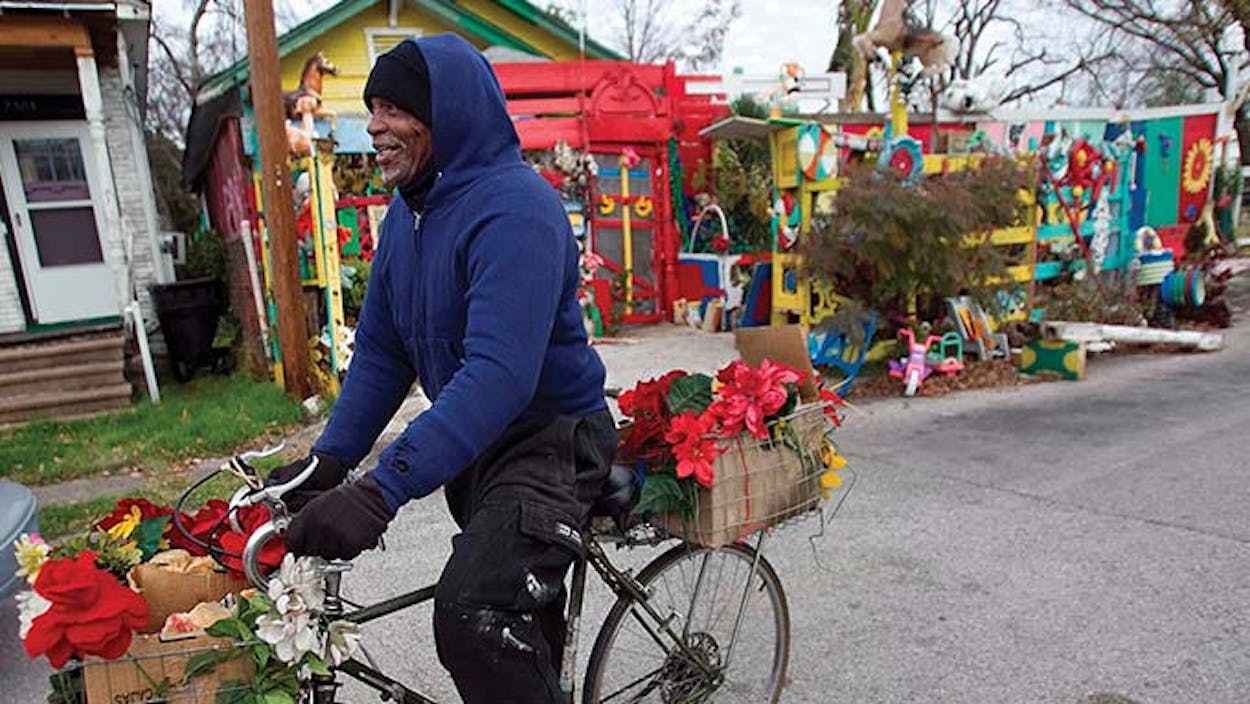For years, Cleveland Turner was a fixture of Houston’s Third Ward, riding his bike every day, foraging for cast-off flowers, misfit toys, and other brightly colored urban detritus to decorate his home at 2305 Francis Street, the third location of the Flower Man House, his decades-long, ever-evolving masterpiece of African American yard-show art. But when Turner fell ill with stomach cancer in 2013, the house ailed as visibly as he did.
“In the final months of his life, when he was unable to work on it, he would apologize to all his visitors, saying, ‘Sorry, it’s not lookin’ just right—there’s not enough flowers here,’ ” says Susanne Theis, the director of programming at Discovery Green park and a longtime champion of Turner’s art. “You could just hear in his voice how horrified he was that people were seeing it like that and thinking that it was the best of his work.”
After Turner died, in December 2013 at age 78, the home began quickly decaying. To passersby, it was little more than a forgotten sloop with a busted mainmast.
And now the house has been demolished.
Usually, when a beloved landmark has a date with the wrecking ball, supporters rally to its defense, claiming that a part of a community’s history is being sacrificed at the altar of gentrification. But there were few, if any, protests about the Flower Man House’s imminent demise.
That’s because the home was beyond any chance of salvation, says Pete Gershon, an administrator at the Glassell School of Art and the author of Painting the Town Orange: The Stories Behind Houston’s Visionary Art Environments. “The house was damaged during Hurricane Ike,” Gershon says. “Water got in. There were animals living in there. They ran a mold report, and human beings should not have been in that house, like, ever. It’s a real toxic, unhealthy situation. Nobody loved the Flower Man more than me, but I’m good with his legacy being preserved through photographs and videos. To have kept the house up, in disrepair, undercuts his legacy.”
Even if the home had been structurally sound and safe for human habitation, it’s not clear how anyone could have kept it moving forward. Turner was constantly adding to and subtracting from the work, cycling many miles in all weather on his mission. The work wasn’t designed to withstand the test of time, especially in a climate as sunbaked and soupy as Houston’s. “We’re talking about a lot of moldy stuffed animals and rotting wood,” says Gershon.
Imagining the Flower Man House without the Flower Man is particularly difficult because Turner’s work was profoundly tied to the circumstances of his own life. His arrival in Houston from Mississippi in 1961 was an unintentional migration. He got off an L.A.-bound Greyhound and was quickly seduced by the local nightlife. Turner spent the next few years working construction; he was also a functioning alcoholic at the time, before an on-the-job injury in 1970 removed “functioning” from the equation. He embarked on a Thunderbird-fueled lost weekend of thirteen years’ duration.
In 1983, too sick to even drink anymore, he ended up in the hospital, where he had a dream that seems to have saved his life. “It was so pretty, all these colors coming from junk, flying high and about like a whirlwind and coming down pretty,” he later told the Houston Chronicle. “So the next day I said, ‘I’ll get me a little house and find junk and hang it up.’ ” He never drank again.
For Turner, his home was less a work of art than a mode of life. “The Flower Man House was always in motion, always in flux,” Gershon says. “It was a beautiful kind of social practice. And in the end, the Flower Man was the art.”
- More About:
- Art








